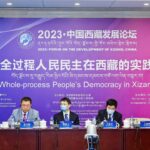Australia is unlikely to publicly endorse China’s membership into the CPTPP, the South China Morning Post reported on Tuesday, citing multiple anonymous sources. According to the report, a source said that “it would be impossible for the Australian government to publicly support the Chinese membership when trade sanctions were in place.”
It has been some time that China’s joining of the CPTPP has become a key topic of discussions on the negotiating table between China and Australia. But it actually represents a key aspect of bilateral common interests if it is looked from a broader perspective.
Chinese Ambassador to Australia Xiao Qian told the Global Times in a recent interview, “The recent gradual resumption of exchanges and cooperation between China and Australia in various fields fully demonstrates that although the two sides have some differences, they have a strong desire for communication and exchanges and extensive and profound common interests.”
Moreover, it should be noted that whether China joins the CPTPP matters not only to Australia, but also to the 11 members under the advanced trade and investment treaty. It is true and understandable that some member states may also have doubts and concerns about China’s application for membership for various reasons, but the reality is that amid the global economic slowdown, market demand has been shrinking sharply, especially in the US and Europe, while China is a relatively large market and also remains on the path to recovery. If China can join the CPTPP, then it will certainly give the Asia-Pacific economy a great boost in terms of both stabilizing growth and moving forward.
Although the CPTPP has been regarded as a high-level free trade development in the Asia-Pacific, the current scale of the trade pact is a far cry from the original intention. The CPTPP, which was called the Trans-Pacific Partnership before the US’ withdrawal under the Trump administration, was supposed to represent 40 percent of the world economy and 20 percent of the global trade, but it is now only equivalent to about 13 percent of global GDP. The downsized economic capacity has always raised doubts as to how much of a role the high-standard CPTPP can play in the region.
At present, most of the CPTPP members have signed bilateral free trade agreements with China and eight of them have China as their largest trading partner, which is a strong basis for China’s inclusion. With China’s participation, the CPTPP would increase its share of global GDP to 30 percent and will offer a huge market space, which will expand not only the benefits of regional cooperation, but also the global influence of the CPTPP.
What’s more important, China’s active application for membership is a manifestation of its willingness to further open up its market.
Some may question whether China can meet the requirements of the CPTPP, but China’s ability and determination to meet the CPTPP standards to achieve further opening-up should not be underestimated. According to China’s Ministry of Commerce, China has already carried out experiments in some pilot free trade zones and free trade ports in accordance with the CPTPP rules, standards and obligations, which will be promoted on a larger scale when conditions are ripe.
As for Australia, the current trade issues between China and Australia won’t – and shouldn’t – be an obstacle to China’s accession. Because as soon as China joins the CPTPP, it will fully implement the rules and standards under the pact, alleviating the trade frictions between the two countries to a certain extent.
In this sense, it is hoped that Australia will not be misled by the idea of Western “de-risking,” but better looking ahead toward the integration of the Asia-Pacific economy.




